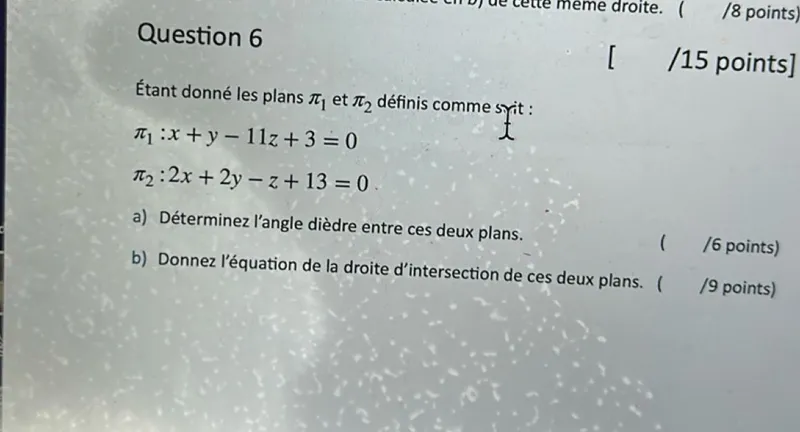Determine the dihedral angle between the two planes.
Calculate the normal vectors of the planes.
The normal vector of plane \(\pi_1\) is \(\vec{n_1} = \begin{pmatrix} 1 \\ 1 \\ -11 \end{pmatrix}\), and the normal vector of plane \(\pi_2\) is \(\vec{n_2} = \begin{pmatrix} 2 \\ 2 \\ -1 \end{pmatrix}\).
Calculate the dot product of the normal vectors.
\(\vec{n_1} \cdot \vec{n_2} = (1)(2) + (1)(2) + (-11)(-1) = 2 + 2 + 11 = 15\)
Calculate the magnitudes of the normal vectors.
\(\|\vec{n_1}\| = \sqrt{1^2 + 1^2 + (-11)^2} = \sqrt{1 + 1 + 121} = \sqrt{123}\)
\(\|\vec{n_2}\| = \sqrt{2^2 + 2^2 + (-1)^2} = \sqrt{4 + 4 + 1} = \sqrt{9} = 3\)
Calculate the cosine of the angle between the normal vectors.
\(\cos \theta = \frac{15}{3\sqrt{123}} = \frac{5}{\sqrt{123}}\)
Find the dihedral angle using the inverse cosine.
\(\theta = \arccos\left(\frac{5}{\sqrt{123}}\right)\)
The dihedral angle between the two planes is approximately \(\boxed{63.20^\circ}\).
Give the equation of the line of intersection of these two planes.
Find a point on the line by setting \(x = 0\).
If \(x = 0\), the equations become:
\[
\begin{array}{l}
y - 11z + 3 = 0 \\
2y - z + 13 = 0
\end{array}
\]
From the first equation, \(y = 11z - 3\). Substituting this into the second equation:
\[
2(11z - 3) - z + 13 = 0 \\
22z - 6 - z + 13 = 0 \\
21z + 7 = 0 \\
21z = -7 \\
z = -\frac{1}{3}
\]
Now, we can find \(y\):
\[
y = 11\left(-\frac{1}{3}\right) - 3 = -\frac{11}{3} - \frac{9}{3} = -\frac{20}{3}
\]
So, a point on the line is \(\left(0, -\frac{20}{3}, -\frac{1}{3}\right)\).
Find the direction vector of the line using the cross product of the normal vectors.
\(\vec{v} = \vec{n_1} \times \vec{n_2} = \begin{pmatrix} 1 \\ 1 \\ -11 \end{pmatrix} \times \begin{pmatrix} 2 \\ 2 \\ -1 \end{pmatrix} = \begin{pmatrix} (1)(-1) - (-11)(2) \\ (-11)(2) - (1)(-1) \\ (1)(2) - (1)(2) \end{pmatrix} = \begin{pmatrix} -1 + 22 \\ -22 + 1 \\ 2 - 2 \end{pmatrix} = \begin{pmatrix} 21 \\ -21 \\ 0 \end{pmatrix}\)
We can simplify the direction vector by dividing by 21: \(\vec{v} = \begin{pmatrix} 1 \\ -1 \\ 0 \end{pmatrix}\).
Write the parametric equations of the line.
The equation of the line is:
\[
\begin{pmatrix} x \\ y \\ z \end{pmatrix} = \begin{pmatrix} 0 \\ -\frac{20}{3} \\ -\frac{1}{3} \end{pmatrix} + t \begin{pmatrix} 1 \\ -1 \\ 0 \end{pmatrix}
\]
So, the parametric equations of the line are:
\[
\begin{array}{l}
x = t \\
y = -\frac{20}{3} - t \\
z = -\frac{1}{3}
\end{array}
\]
The equation of the line of intersection is \(\boxed{\begin{pmatrix} x \\ y \\ z \end{pmatrix} = \begin{pmatrix} 0 \\ -\frac{20}{3} \\ -\frac{1}{3} \end{pmatrix} + t \begin{pmatrix} 1 \\ -1 \\ 0 \end{pmatrix}}\).
The dihedral angle between the two planes is approximately \(\boxed{63.20^\circ}\).
The equation of the line of intersection is \(\boxed{\begin{pmatrix} x \\ y \\ z \end{pmatrix} = \begin{pmatrix} 0 \\ -\frac{20}{3} \\ -\frac{1}{3} \end{pmatrix} + t \begin{pmatrix} 1 \\ -1 \\ 0 \end{pmatrix}}\).






